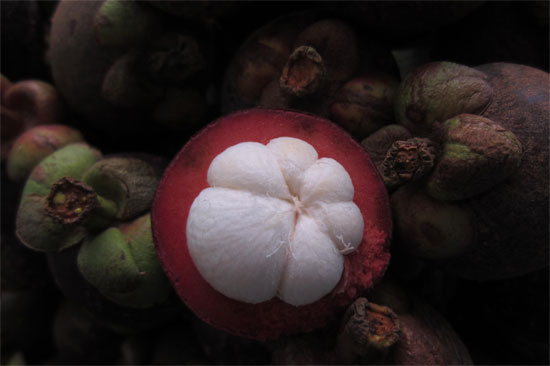Separation of glucose-lowering activity from basil leaves and mangosteen peels
After 12 months, the young research team of the Organic Chemistry Department, Institute of Chemical Engineering has successfully studied the process of extracting and isolating some bioactive compounds (antioxidant, blood glucose lowering . ) from the leaves of the leaves and the mangosteen pods at the laboratory scale.
Potential science and technology topic 'Study on the process of extracting and separating segments with biological activity from xakea and mangosteen' funded by the Ministry of Science and Technology to study with the goal of creating Preparations to support the treatment of diabetes and hypertension.
Associate Professor, Dr. Tran Thu Huong, Chairman of the scientific project, said that during the process of implementing the topic, the group collected medicinal samples, assessed scientific names; using a combination of traditional and modern extraction methods, creating extracts for chemical and biological research; Study to isolate bioactive compounds from the leaves of the leaves and the mangosteen pods.
The team determined the chemical structure of the compounds isolated by modern physical methods; assessing biological activity of extract samples and active ingredients in the direction of antioxidant activity, blood glucose lowering .
By combining modern chromatographic and spectroscopic methods, the study has isolated and determined the structure of 17 compounds, including two new compounds from the leaves of the leaves and the mangosteen pods.

Photo: internet
Technology that the research team built integrates many modern chemical-biological-physical-pharmaceutical methods. With this technological process, from dry leaves of xakea, the research team has isolated nine compounds, including a new compound for the first time isolated from the leaves of the leaves in Vietnam.
The results of the activity test showed that the extract as well as the compounds isolated from the leaves of the plant had a good antioxidant effect, inhibiting enzymes associated with glucose metabolism causing diabetes.
From mangosteen pods, the team also isolated 8 compounds, including a new compound for the first time isolated. These compounds are capable of inhibiting relatively strong α-glucosidase and α-amylase enzymes, in which gartanin has the strongest α-glucosidase inhibitory activity.
The extracts obtained from the two sources were tested in vivo on pure BALB / c mice (mice specialized for immunity testing). The results show that these extracts have a positive effect in supporting diabetes treatment.
'Another highlight of the project is that the young research team has successfully researched and manufactured materials γ aluminum oxide with a pore size of about 6-10nm, containing many groups of -OH on the surface in large quantities. weak and medium acidic centers with high mechanical strength and durability against solvents used in the process of extraction, extraction and good regeneration, meeting the adsorption requirements of bioactive compounds . This is a good material to use in the process of isolating a large number of natural compounds towards industrial scale technology with low cost , 'said Associate Professor, Dr Tran Thu Huong.
According to Associate Professor, Dr. Tran Thu Huong, the first step has achieved certain results on the isolation of compounds and the search for bioactive substances (antimicrobial, antioxidant anti-oxidant blood .) from the leaves of the leaves and the mangosteen pods - a rich source of materials, available in many provinces and cities in Vietnam.
However, Associate Professor, Dr. Tran Thu Huong also expressed her desire: "In order to apply these research results into practice, it is necessary to expand the study of chemical composition by location and time. sample collection point.
In addition to expanding the investigation of hypoglycemic activity, other biological activities of these plants should also be invested in a more intensive research direction, upgrading technology with a larger scale to soon bring results. research into practical applications ".
- Things you don't know about lemon basil
- When should I put glucose into my body?
- The best parts of vegetables are often removed
- Grow basil in a simple hydroponic way at home
- What happens when driving through banana peels?
- Slimming and lowering blood fat with Oriental medicine
- Fruit peels can also save lives
- The reason the whole world is gradually turning to banana peels
- Blood glucose meter, health care therapy
- Special technology leaves the leaves after a few hours
- Turn leaves into creativity 'no one expected
- Salt separation technology: Israeli
 'Barefoot engineer' invents a pipeless pump
'Barefoot engineer' invents a pipeless pump Process of handling dead pigs due to disease
Process of handling dead pigs due to disease Radiometer
Radiometer Warp Engine: Technology brings us closer to the speed of light
Warp Engine: Technology brings us closer to the speed of light Successfully extracted anti-cancer compounds in milkweed
Successfully extracted anti-cancer compounds in milkweed  Cat beard has precious active ingredients that inhibit diabetes
Cat beard has precious active ingredients that inhibit diabetes  Isolating the anti-cancer active substance from the roots of disease-spreading plants
Isolating the anti-cancer active substance from the roots of disease-spreading plants  When cleaning floors with bleach, do not turn on the lights
When cleaning floors with bleach, do not turn on the lights  Russia has developed a new source of anti-virus medicine
Russia has developed a new source of anti-virus medicine  Discover how cannabis plants 'synthesize' pain killers
Discover how cannabis plants 'synthesize' pain killers 